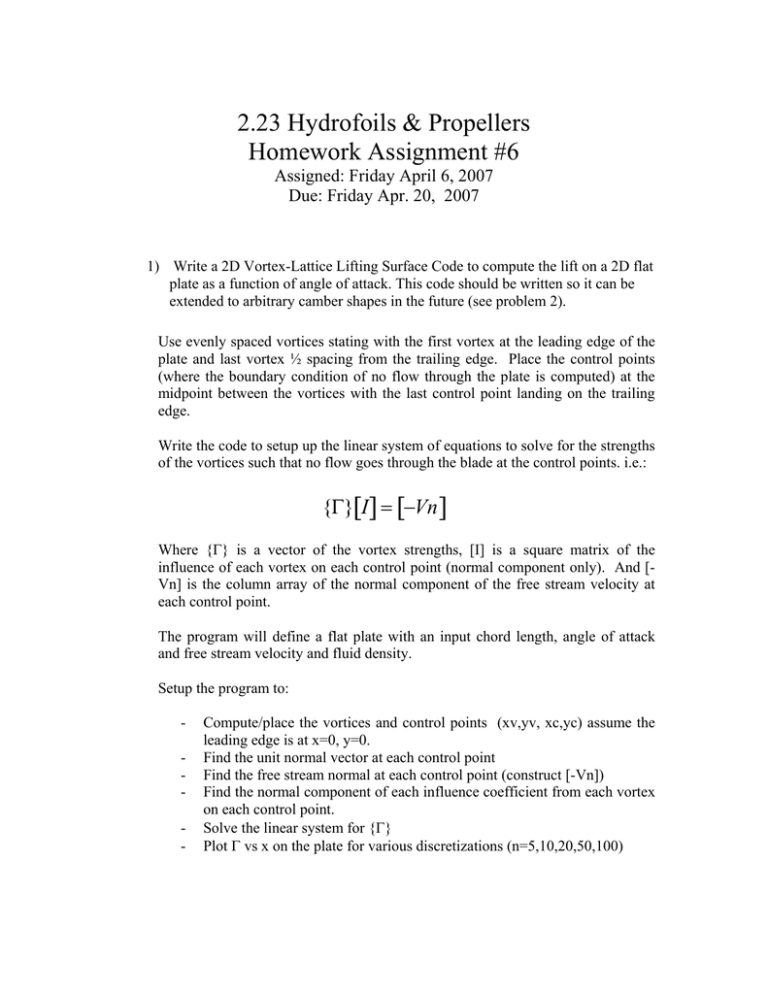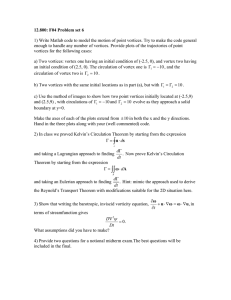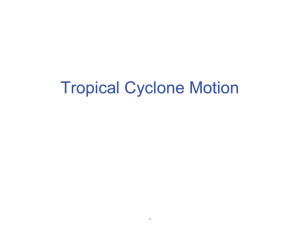2.23 Hydrofoils & Propellers Homework Assignment #6
advertisement

2.23 Hydrofoils & Propellers
Homework Assignment #6
Assigned: Friday April 6, 2007
Due: Friday Apr. 20, 2007
1) Write a 2D Vortex-Lattice Lifting Surface Code to compute the lift on a 2D flat
plate as a function of angle of attack. This code should be written so it can be
extended to arbitrary camber shapes in the future (see problem 2).
Use evenly spaced vortices stating with the first vortex at the leading edge of the
plate and last vortex ½ spacing from the trailing edge. Place the control points
(where the boundary condition of no flow through the plate is computed) at the
midpoint between the vortices with the last control point landing on the trailing
edge.
Write the code to setup up the linear system of equations to solve for the strengths
of the vortices such that no flow goes through the blade at the control points. i.e.:
{Γ}[I ] = [−Vn ]
Where {Γ} is a vector of the vortex strengths, [I] is a square matrix of the
influence of each vortex on each control point (normal component only). And [Vn] is the column array of the normal component of the free stream velocity at
each control point.
The program will define a flat plate with an input chord length, angle of attack
and free stream velocity and fluid density.
Setup the program to:
-
Compute/place the vortices and control points (xv,yv, xc,yc) assume the
leading edge is at x=0, y=0.
Find the unit normal vector at each control point
Find the free stream normal at each control point (construct [-Vn])
Find the normal component of each influence coefficient from each vortex
on each control point.
Solve the linear system for {Γ}
Plot Γ vs x on the plate for various discretizations (n=5,10,20,50,100)
Once the solution is complete write an analysis code to compute the following:
-
The horizontal and vertical velocity at each vortex (including inflow)
The lift for each vortex (Lv = ρVhΓ) and the total lift and lift coefficient of
the plate.
Plot the lift coefficient vs. alpha for a range of vortex discretizations (n=5
to n=100)
Compare these plots to the theoretical result Cl = 2πα
2) Extend the capability of your 2D hydrofoil code to a cambered meanline with
thickness. Write your code to read in camber and thickness offsets from a file,
spline these curves with a cubic B-spline and interrogate the offsets. Also
include the ability to scale the camber and thickness. As a test case, construct a
camber/thickness file for a parabolic meanline of 4% and an elliptical thickness
of 3%. The meanline should NOT be linearized, in other words the vortices
and control pints should lie on the meanline.
a) Run your code and plot the Lift coefficient vs angle of attack for angles
from -3 degrees to 10 degrees. Also plot the theoretical result.
b) Plot the upper and lower chordwise pressure distribution (Cp) at an
angle of attack of zero degrees and 1 degree. Plot is the cavitation
number for cavitation inception for this foil as a function of CL and
alpha.
Also include a copy of your matlab code with the assignment.





